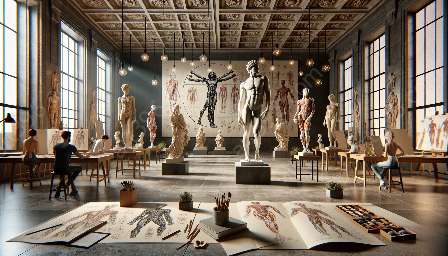Artists have long been fascinated by animal anatomy and have adapted it to create stylized and abstract representations in visual art. This topic explores the intersection of animal anatomy in art and artistic anatomy, delving into the creative techniques used by artists to reimagine the natural world and bring their unique visions to life.
Understanding Animal Anatomy in Art
Animal anatomy has been a subject of artistic study for centuries, with artists seeking to understand the structures and forms of various creatures in order to accurately portray them in their work. Classic examples of this include Leonardo da Vinci's detailed anatomical studies of horses and other animals, as well as the animal sculptures of the ancient Greeks and Romans.
However, as art has evolved, so too have the ways in which artists approach animal anatomy. Rather than striving for strict realism, many artists now use animal anatomy as a foundation for more abstract and stylized representations. By bending and distorting the natural forms of animals, artists can create unique and expressive works that evoke a sense of emotion and movement.
Adapting Animal Anatomy for Stylized Art
One of the key methods through which artists adapt animal anatomy is through stylization. This involves simplifying and exaggerating the features of animals to create a more graphic and engaging representation. For example, an artist may elongate the neck of a giraffe or enlarge the eyes of an owl to create a whimsical and expressive portrayal.
Stylization allows artists to emphasize certain characteristics of animals, drawing attention to their inherent beauty or grace. This approach is often seen in illustration, animation, and character design, where artists seek to create memorable and iconic depictions of animals that transcend strict realism.
Exploring Abstract Representations of Animal Anatomy
While stylization focuses on simplifying and exaggerating animal forms, abstract representations take this concept even further by distorting and reshaping anatomy in unexpected ways. Artists may deconstruct animal forms into geometric shapes, use vibrant colors and patterns, or merge multiple animal anatomies together to create surreal and dreamlike compositions.
Abstract representations of animal anatomy challenge viewers to reinterpret their perception of the natural world, inviting them to explore the fluid boundaries between reality and imagination. Through these artistic explorations, animals become symbolic vessels for larger emotional and conceptual narratives, transcending their literal forms to evoke powerful and thought-provoking responses.
The Intersection of Animal Anatomy in Art and Artistic Anatomy
At the intersection of animal anatomy in art and artistic anatomy lies a rich tapestry of creative possibilities. By adapting and reimagining the natural world, artists can forge new connections between human experience and the animal kingdom, infusing their work with emotional depth and expressive resonance.
Through the exploration of stylized and abstract representations of animal anatomy, artists contribute to a vibrant tradition of visual storytelling, using the rich language of form and composition to convey profound insights and evoke powerful emotions. As they continue to push the boundaries of artistic expression, artists inspire us to see the world through fresh eyes and embrace the endless possibilities of creative reinvention.

